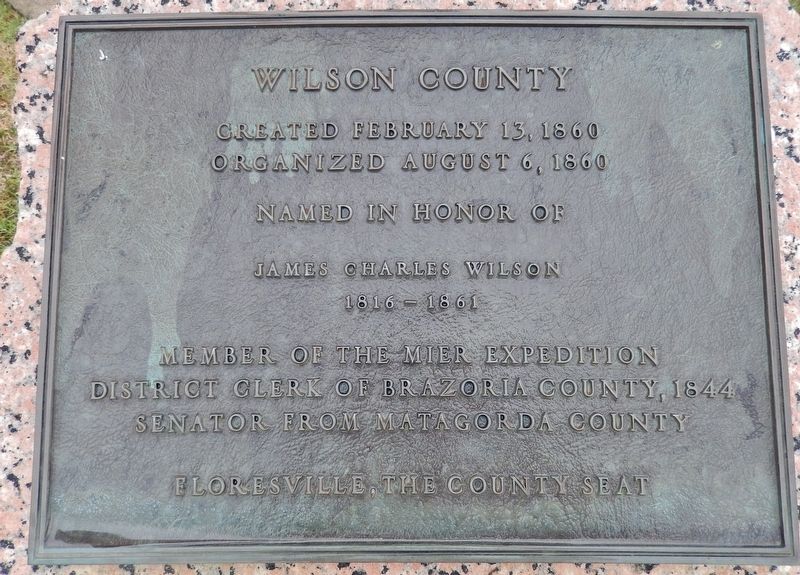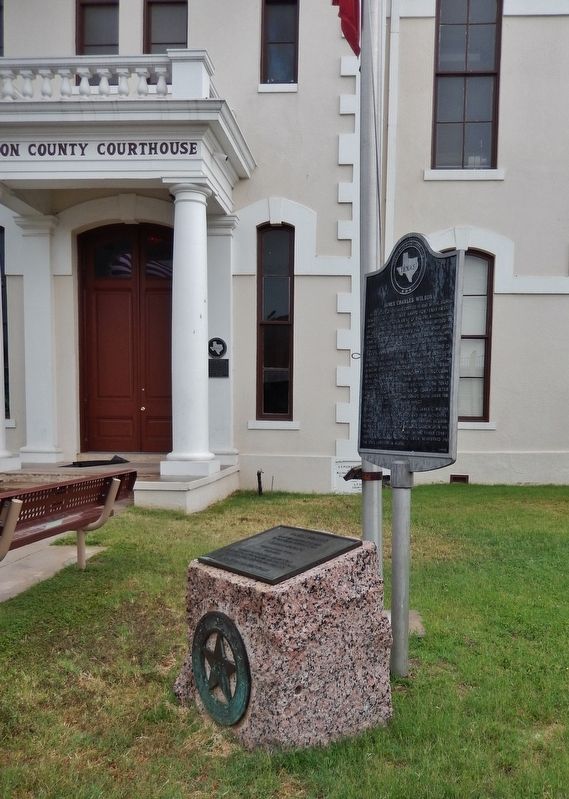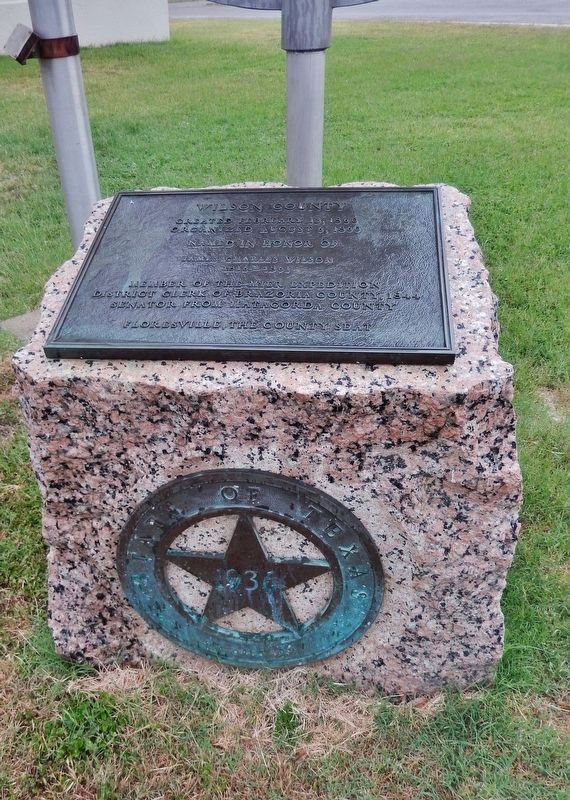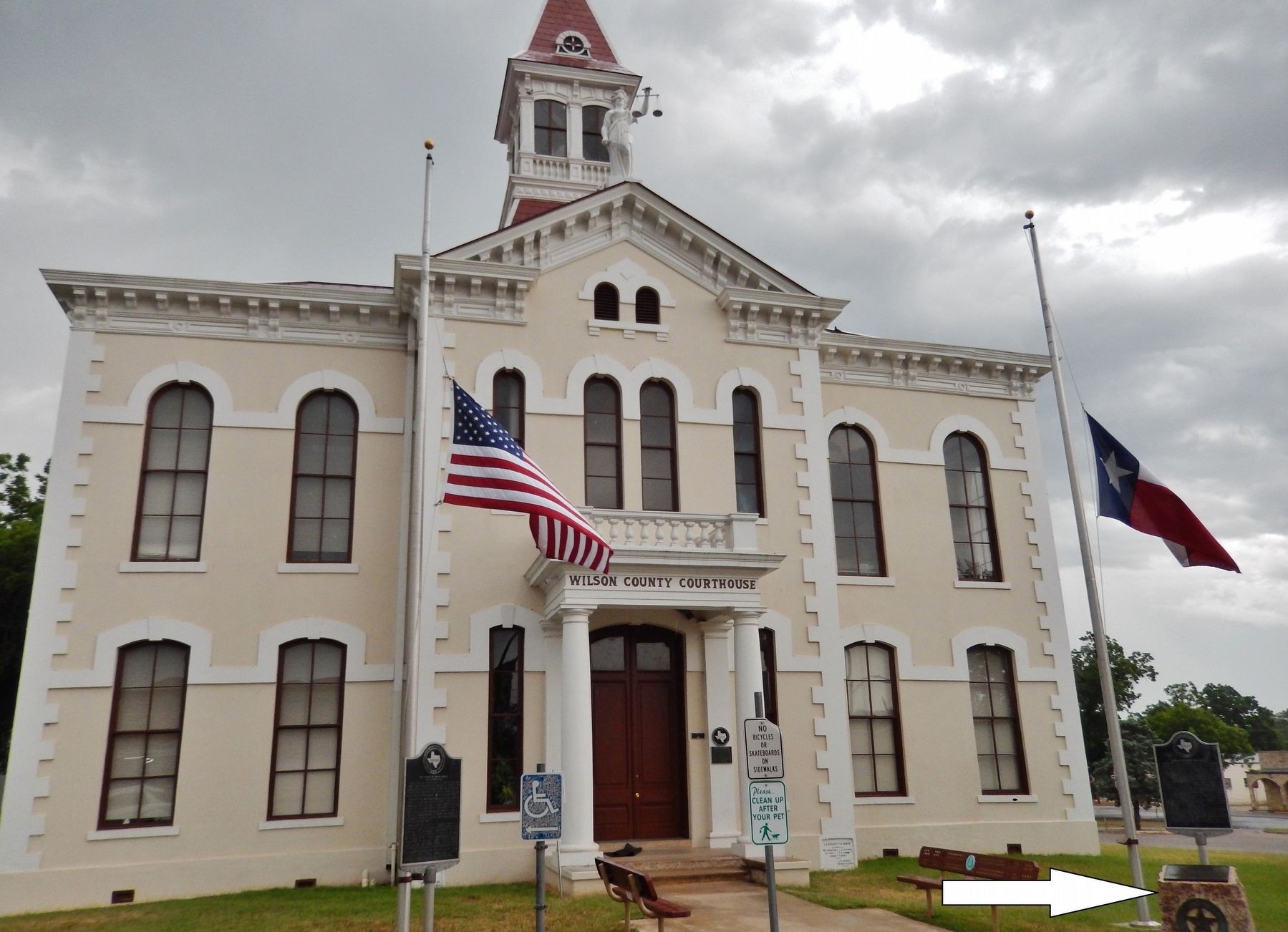Floresville in Wilson County, Texas — The American South (West South Central)
Wilson County
Created February 13, 1860
Organized August 6, 1860
Named in honor of
James Charles Wilson
1816 – 1861
Member of the Mier Expedition
District Clerk of Brazoria County, 1844
Senator from Matagorda County
Floresville, the County Seat
Erected 1936 by Texas State Highway Department. (Marker Number 5855.)
Topics and series. This historical marker is listed in this topic list: Political Subdivisions. In addition, it is included in the Texas 1936 Centennial Markers and Monuments series list. A significant historical year for this entry is 1860.
Location. 29° 7.985′ N, 98° 9.453′ W. Marker is in Floresville, Texas, in Wilson County. Marker is on 3rd Street north of D Street, on the right when traveling north. Marker is located on the west side of the Wilson County Courthouse. Touch for map. Marker is at or near this postal address: 1420 3rd St, Floresville TX 78114, United States of America. Touch for directions.
Other nearby markers. At least 8 other markers are within walking distance of this marker. James Charles Wilson (here, next to this marker); The Flores de Abrego Family and Floresville (here, next to this marker); Wilson County Courthouse (a few steps from this marker); Captain Will Wright (within shouting distance of this marker); Wilson County Jail (about 300 feet away, measured in a direct line); White House Café and Saloon (about 600 feet away); First Baptist Church of Floresville (approx. 0.2 miles away); Floresville United Methodist Church (approx. 0.2 miles away). Touch for a list and map of all markers in Floresville.
Also see . . .
1. Wilson County. The area that now comprises Wilson County was in the hunting range of Comanche, Tonkawa, and Lipan-Apache Indians. The first Europeans to reach the territory were Spanish explorers, who traveled through the area in the early eighteenth century. In September 1718 Martín de Alarcón crossed the area on his way to explore the bay of Espíritu Santo, and in 1727 Pedro de Rivera y Villalón went north across the territory on his tour of inspection between La Bahía and Bexar. (Submitted on May 23, 2018, by Cosmos Mariner of Cape Canaveral, Florida.)
2. Wilson County, Texas. By the eve of the Civil War Wilson County had a population of 1,500. Because of the emphasis on cattle-raising rather than a plantation economy, the number of slaves remained small; in 1860 there were only a few hundred slaves in the county. Nevertheless, Wilson County residents voted for secession and most actively supported
the Confederate cause. Several companies of militia were organized. A protracted period of drought lasting from 1862 to 1865 further compounded wartime hardships. Because of the relatively small number of slaves, however, abolition did not affect the fortunes of Wilson County residents as severely as it did in other counties, and the economy rebounded more quickly than in many other parts of the state. (Submitted on May 23, 2018, by Cosmos Mariner of Cape Canaveral, Florida.)
3. Wilson County, Texas. Fence Cutting Wars in Texas lasted for approximately five years, 1883-1888. The 40,000-acre ranch of Houston and Dilworth became the focal point in Wilson County. As farmers and ranchers began to compete for precious land and water, cattlemen found it more difficult to feed their herds, prompting cowboys to cut through fences. Texas Governor John Ireland prodded a special assembly to order the fence cutters to cease. In response, the legislature made fence-cutting and pasture-burning crimes punishable with prison time, while at the same time regulating fencing. The practice abated with sporadic incidents of related violence 1888. (Submitted on May 23, 2018, by Cosmos Mariner of Cape Canaveral, Florida.)
4. James Charles Wilson. James Charles Wilson, senator, was born in Yorkshire, England, on August 24, 1816. He attended Oxford University before he moved to Texas in 1837. He joined Charles
K. Reese's company for the Somervell expedition in 1842 and became a private in Company E on the Mier expedition under William S. Fisher. Captured with that expedition, he refused the proffered help of the British government on the grounds that he was an English citizen and remained in prison until he managed to escape on July 30, 1843. (Submitted on May 23, 2018, by Cosmos Mariner of Cape Canaveral, Florida.)
Credits. This page was last revised on June 5, 2020. It was originally submitted on May 22, 2018, by Cosmos Mariner of Cape Canaveral, Florida. This page has been viewed 209 times since then and 23 times this year. Photos: 1. submitted on May 22, 2018, by Cosmos Mariner of Cape Canaveral, Florida. 2, 3, 4. submitted on May 23, 2018, by Cosmos Mariner of Cape Canaveral, Florida. • Bernard Fisher was the editor who published this page.



